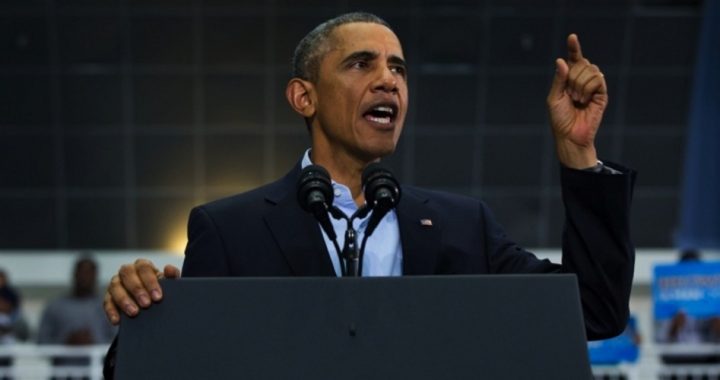
While President Barack Obama said, during his first presidential campaign in 2008, that he thought marriage was strictly between one man and one woman, he now has confidently stated that same-sex marriage is guaranteed under the “equal protection” clause of the Fourteenth Amendment.
This is not Obama’s first change of position on the issue. When campaigning for reelection in 2012, he decided that same-sex marriage was an issue best left to the states.
Now, Obama recently told Jeff Toobin of the New Yorker magazine that the recent decision of the Supreme Court to refuse to hear appeals from circuit courts on the issue was the best decision the Court has made since he took office. After more than one circuit court overturned states’ laws against same-sex marriage as a violation of the “equal protection” clause of the 14th Amendment, the Supreme Court declined to even hear appeals, letting the appellate courts’ decisions stand.
“Ultimately, I think the Equal Protection Clause does guarantee same-sex marriage in all fifty states,” Obama told the New Yorker.
It is beyond belief that the Congress which passed the 14th Amendment, and the states which voted to ratify it, intended to enshrine the marriage of a man to a man, and a woman to a woman, as a “constitutional right.”
Actually, it appears quite unlikely that the creators of the 14th Amendment intended many of the things modern judges claim were intended. Certainly the Bill of Rights, added to the Constitution in 1791, was designed to protect the states and American citizens from the power of the federal government. One only has to look at the 10th Amendment, which clearly states that all powers not delegated to the federal government are “reserved” to the states and the people. Judicial decisions of recent decades, which use the 14th Amendment, specifically the “equal protection” clause, to increase federal power at the expense of the states, turn the Bill of Rights on its head.
In the 1833 decision Barron v. Baltimore, Chief Justice John Marshall wrote, “Had Congress engaged in the extraordinary occupation of improving the Constitution of the several states by affording the people additional protection for the exercise of power by their own governments in matters which concerned themselves alone, they would have declared this purpose in plain and intelligible language.” The states were exempted from the restrictions of the Bill of Rights (the states typically had their own constitutions with their own bills of rights).
But did the 14th Amendment change all that, and “incorporate” the Bill of Rights, and make them applicable to restrict state governments, or more specifically, transfer any judicial review from state to federal courts?
It is clear from the historical record that the 14th Amendment had a dual purpose. First, many members of Congress expressed concern that they lacked constitutional authority to enact into law the provisions of the Civil Rights Act of 1866. (This seems almost odd to the modern ear — members of Congress actually expressing concern that something they are considering doing might be in violation of the U.S. Constitution, and therefore they refrain from doing it.)
A second reason for the proposed constitutional amendment was to define citizenship in such a way as to make the former slaves citizens of the United States, and thus entitled to the same protections of the law that states afforded each of their own citizens. This was considered necessary because of a previous Supreme Court decision in 1857 (Dred Scott v. Sanford) which had declared that Blacks were not citizens. Congress had previously passed the Civil Rights Act in reaction to the notorious Black Codes enacted in several southern states. The codes attempted to create a system of apprenticeship, labor restrictions, and vagrancy laws for the purpose of reversing the recent emancipation of the slaves with the 13th Amendment. Concerned that Congress might repeal the Civil Rights Act if the Democrats returned to power, Republicans pushed through the constitutional amendment, which was basically identical to the Civil Rights Act. This would place its provisions beyond the ability of any future Congress to simply repeal them.
In an 1879 decision, Missouri v. Lewis, Justice Joseph Bradley held that the 14th Amendment “does not profess to secure to all persons in the United States the same laws or the same remedies. Great diversities in these respects may exist in two states separated by an imaginary line.”
Over the next few decades, federal courts consistently refused to apply the Bill of Rights to restrict state governments, despite the passage of the 14th Amendment.
It was not until 1925 that the Supreme Court made any moves toward what is now known as the “incorporation doctrine,” the assertion that the 14th Amendment “incorporated” at least some of the provisions of the Bill of Rights to restrict actions of state governments. The first tentative move in that direction came with the decision Gitlow v. New York, which said states must respect the freedom of speech provisions found in the First Amendment to the federal Constitution. Not long after that, Charles Warren wrote in an article in the Harvard Law Review predicting the Court had established the precedent to apply the remainder of the Bill of Rights so as to restrict the states in the federal court system.
Warren was proved correct, and today the average American does not even question the authority of the federal courts to simply substitute their judgment for what the people and their legislators have decided in the several states. Courts, breaking the chain of the Constitution, now consider themselves a super-legislature, unelected and unaccountable to the people, the Constitution, or even God. Raoul Berger, in The Fourteenth Amendment and the Bill of Rights, put it very well: “Against the historical evidence, ‘equal protection’ has become a crystal ball in which judicial soothsayers can find whatever they will.” Justice John Harlan expressed it similarly: “When the Court disregards the express intent and understanding of the Framers, it has invaded the realm of the political process to which the amending power was committed, and it has violated the constitutional structure which is its highest duty to protect.”
Yet, we have a situation, blessed by the president of the United States, in which federal judges regularly ignore the clear wording of the Constitution, and substitute their own social views for the majority of citizens in several states, using the expression “equal protection” as a way of amending the Constitution, without going through the constitutional amendment procedure.
No one seriously believes the framers of the 14th Amendment intended to outlaw the definition of marriage as between one man and one woman, and then proceed to force the states to accept that definition. While the framers of the Constitution provided for a way to amend the Constitution in Article V of the document, that method is usually not even considered. No, the preference now is to simply ignore the Constitution and the will of the people, and “amend” the Constitution through a misconstruction of the “equal protection” clause of the 14th Amendment. The constitutional method of amending the Constitution has now been replaced by an unconstitutional method of amending the Constitution.
Photo of President Barack Obama: AP Images



